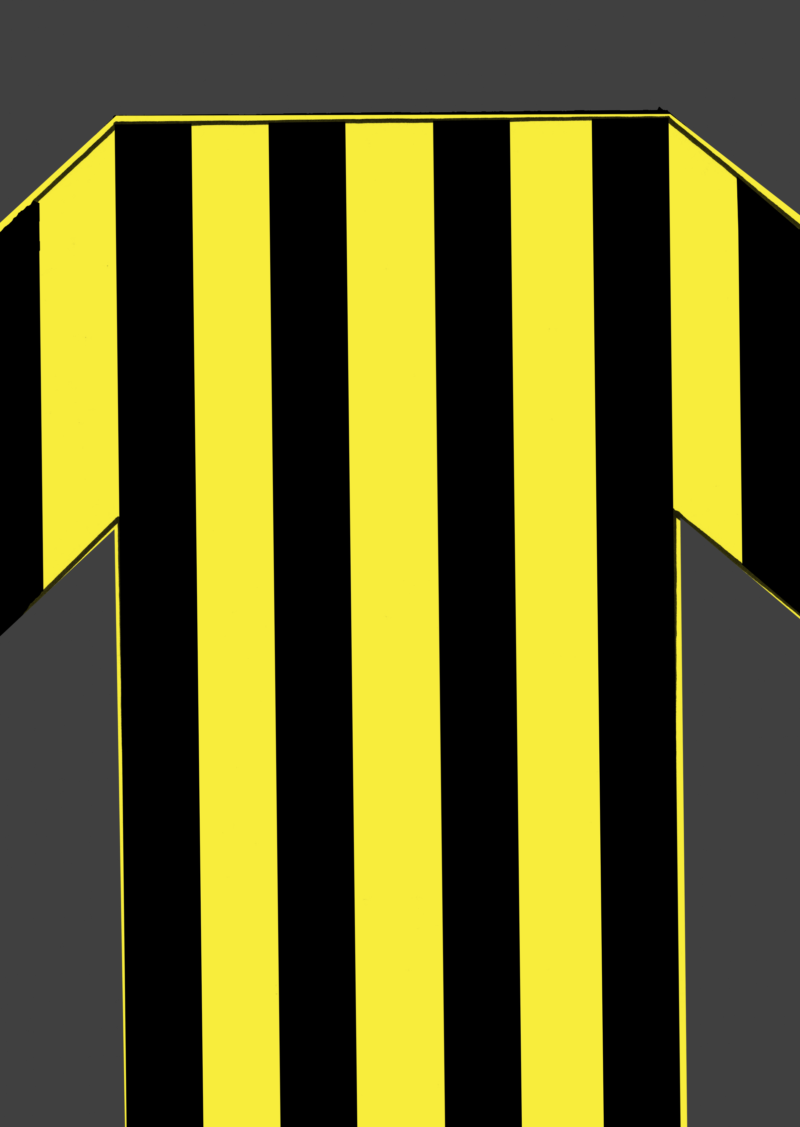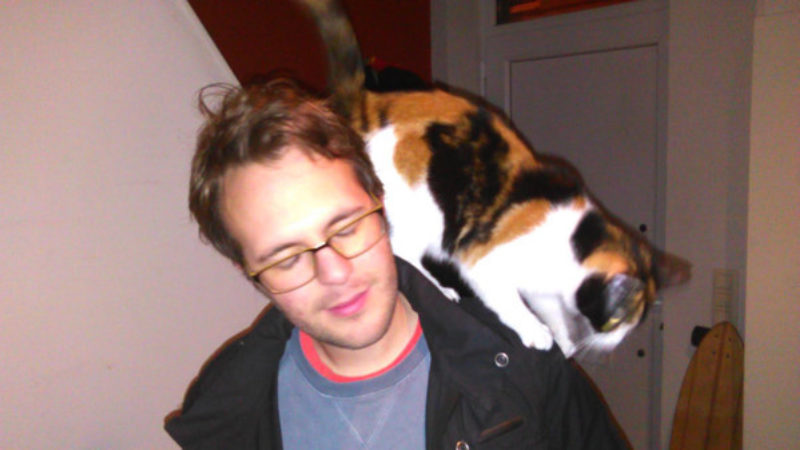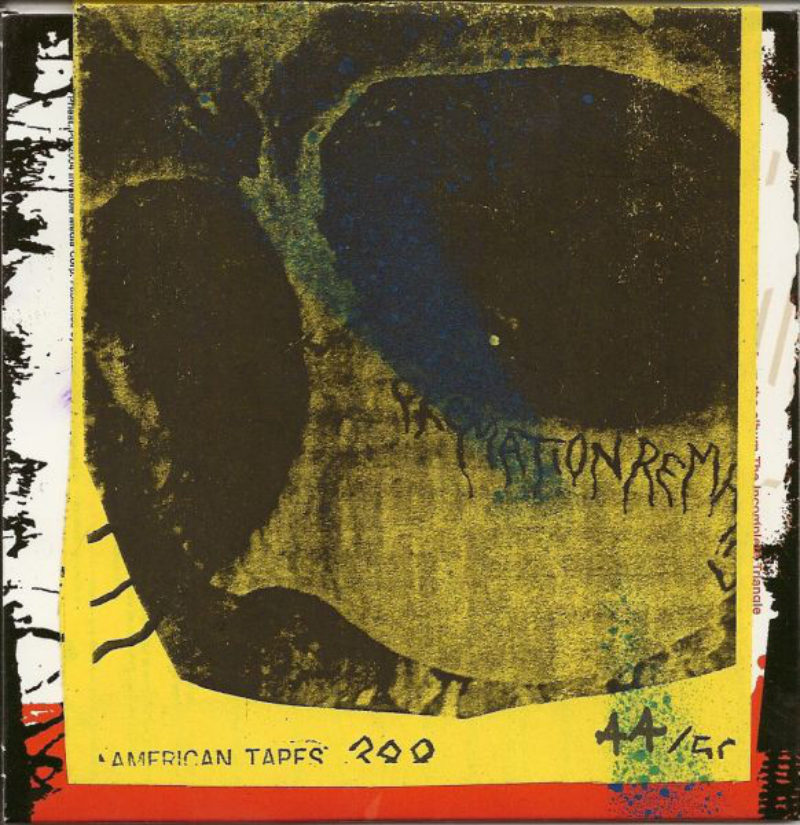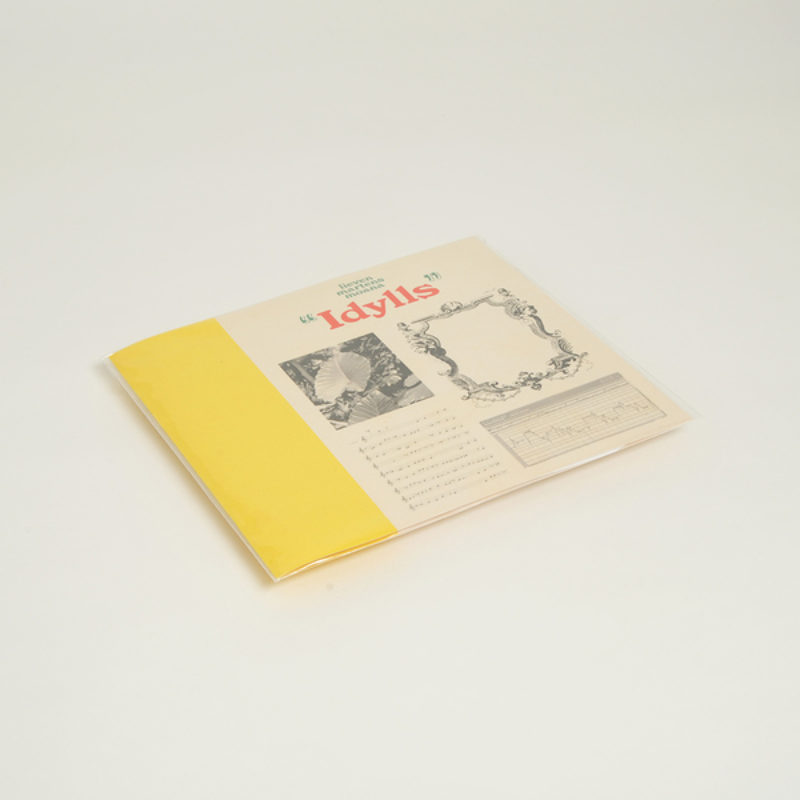Jeroen Wille

One of the attending publishers was audioMER, the label of Jeroen Wille and Wouter Van Haelemeesch, which is closely related to the publishing house MER. Paper Kunsthalle. Wille has done the graphic design for an important share of the latters’ publications. Also present was het balanseer, a publishing house for which Jeroen Wille designed some of the publications of Willy Roggeman, amongst others. Another guest was Edições CN, the publishing platform of Lieven Martens Moana — and guess who’s the graphic designer behind these albums? Right, Jeroen Wille. We could go on for a while, the list is long... So it seemed like a logical choice to interview Jeroen instead of the labels and acts present. (By the way, in cooperation with our regular design partner Ruud Ruttens, Jeroen also designed this journal).
Pauwel De Buck
Can I offer you a drink, Jeroen?
Jeroen Wille
I fancy that Saison de Dottignies... I don’t have it in Untapped yet (app that keeps track of one’s beer consumption).
PDB
Did you know that Manuel Padding (City Hands) just added his 1000th beer brand on Untapped?
JW
Interesting, but I probably won’t go that far.

PDB
I thought it was a great idea to do an interview with you, since you are a substantial contributor to The Avant-Guardian — albeit behind the scenes, unlike the artists that feature in it.
JW
In 2011, the previous generation of KRAAK-guys (Steve Marreyt and Tommy Denys) asked me to do a publication for the Drieklank festival. I worked with Thomas Desmet on that, while other publications were created by Niels Latomme and graphic designers Mathieu Serruys, Timo Bonneure, and Kahil Janssens. So when you asked me to make an Avant-Guardian for the Eastern Daze festival in 2015 (AG6), it was in fact a follow-up on what I did before, regarding paper choice and dimensions. In the first two editions (AG6 and AG7) I was mostly searching for a format I could feel comfortable with. It’s only with AG8 that we started to feel that the format was working out and getting somewhere. Personally, I like the idea of evolution in a certain design, that it has the time to grow organically and doesn’t need to be strictly defined from the beginning. The AG doesn’t operate on a strictly functional and informative level; dimensions are substantial, it’s almost bulky. In a day and age where newspapers increasingly start to look like lifestyle zines, you can consider this a statement. The paper behaving somewhat as an unruly physical object is fully intentional. Just as the music that it features doesn’t necessarily qualify as cheerful. We hope that people take an interest and see them as collectible period documents, which they might refer to in the future. Ruud Ruttens is very important in this. We cooperate very closely in designing the AG. Without him, the result would be less interesting.
PDB
That is true. A double interview with you and Ruud would have been appropriate, as his input in this is equally valuable. But the reason it’s you that I am interviewing is because of your longlasting involvement in the Belgian offstream music scene. Besides KRAAK, you are responsible for the design and layout of a lot of other labels.
JW
I have been around for some time, absolutely. Prompted by the invitation for this interview, I asked myself where we had met for the first time. It must have been around 2006 or 2007, when you performed in the Frontline in Ghent. I found that out by consulting one of the spreadsheets with info that I started and kept up to date over the course of a few years. I was inspired by Project Blood Team, a closed online community that included musicians like C. Spencer Yeh (Burning Star Core, solo projects and other collaborations) and John W. Fail (Lied Music). These lists are probably an expression of some of my neurotic tendencies. They almost have therapeutic value: I can easily occupy myself with tagging mp3s, sorting fonts etc., for hours on end. Maybe it’s an absurd craving for orderliness, or fear of forgetting? There is no real purpose involved, although it can be fun to look back. In the same way I remember you performing in June 2008 in the Witte Zaal on an Odradek night (Han Van den Hoof organized concerts under that name, as well as releasing music). Remember, these were pre-Facebook times. No apps, but forums and blogspots aplenty. People would keep track of what they went to see and listened to on these forums. The discussions that ensued made these into a much more dynamic, inspiring and creative community than is the case with modern social media. I have to admit that it is something I miss a little. The pleasure of discovery was much more intense in pre-internet times: either you stumbled upon something by chance or you heard a rumour and set off on a quest in record shops that could last for months! Nowadays, search and discovery is largely directed by consumer-oriented algorithms run by multinationals. It’s true that social media do encourage young people to release their music and quickly generate large audiences. But there is some perversity involved: it’s all about creating images and true meaning has no part in it. I miss authenticity. Not much Industrial, Black Metal, Acid House, or Punk is truly authentic today; at heart it’s empty and ornamental. Fashion and branding are key words. This is also true for graphic design, which I often find overrated. Design should express its own reason for existence, by using the means at hand. That’s why a grind-core tape from 1986, or a spray-painted American Tapes CD-R from 2003 still stands on its own. What’s also sad is the way the Internet submits everything to the market: even the most obscure recordings are easily available from discogs.com.

PDB
I got to know you when you were already deeply involved with that whole scene. I was dragged into it by some friends in school; how did it go for you?
JW
For us, the scene is a familiar expression. But things are not so clear. Isn’t a scene always linked to a well-defined musical genre? KRAAK doesn’t fit in that picture. If there is something defining it, it would be a certain type of concerts and an incessant curiosity about new and different music. I discovered a lot of music through Freaks End Future, a legendary record shop in Antwerp, run by the musical chameleon and cult figure Carlo Steegen. I went to see concerts there and easily left behind a month’s wages buying records, tapes and magazines. His label, Audiobot, probably inspired me as well to start releasing things of my own. I’m talking about audioMER that I run in collaboration with artist and concert promoter Wouter Vanhaelemeesch. I met a whole bunch of people there: Dennis Tyfus, Lieven Martens (who was mainly occupied at the time with his Imvatedlabel), Koen Vandenhoudt (Zaal België then, Oorstof and Dropa Disc now), Hans Mortelmans (Robo Records), Bart De Paepe (Sloow Tapes), Erik Van Looy from Borsbeek — who organised Neobilly festivals between 1988 and 1992 and is a great source of inspiration thanks to his encyclopaedic knowledge of music...
I already knew Joris Verdoodt (B.A.A.D.M.). He ran Kapellmeister Grammofon at the time, together with Jeroen Provoost. I also went to the concerts organised by Laura Maes and Kevin Van Volcem (Cling FilmRecords / Kling Film-Records), but I didn’t get involved with them beyond that. Of course I knew KRAAK (Johan Loones and Dave Driesmans at the time) through RifRaf and Humo. The first Köhn albums were well received and that got my attention. For my historical background I owe a lot to the influential Nurse With Woundlist, but also to charismatic Timo Van Luijk (Af Ursin, La Scie Dorée, etc.), whom I interviewed myself once, for the predecessor of The Avant-Guardian (Ruis, November 2006, p. 7-8). Long before any reissue hype he tipped me off on Taj Mahal Travellers, East Bionic Symphonia, and Albert Ayler’s Fondation Maeght concerts.
Through Carlo’s shop I also discovered the CD-R releases of Funeral Folk (Silvester Anfang, Hellvete). I suddenly realised that many of these musicians grew up in the region where I came from, but in Meetjesland people tend to live very isolated, so chances to meet fellow travellers are much greater in cities like Ghent or Antwerp, than in the countryside. I remember setting a meeting with someone I didn’t know in the marketplace of Maldegem to buy some CD-Rs, and that guy became one of my best friends. The face-toface aspect, getting in touch with each other, is an important characteristic of the whole scene. Often, you get to meet the people behind the label. Their story invariably goes beyond merely releasing an album, and that helps you to understand a certain vision. Record stores have always been hugely important to me. At the end of the 90s, for example, I was a frequent visitor of Epoxy in Eeklo. this is the place that made me discover bands such as Coil and Death In June, but also Staalplaat’s Mort Aux Vaches series (especially the O Yuki Conjugate and Deutsch Nepal discs). The scent of heavy pipe tobacco in the store and the many conversations with shop owner Willy Vertongen are strong personal memories.
PDB
Personally I don’t spend much money on records, I often wonder how collecting can cause such obsessive behaviour. Turns out a shopping addiction is often part of the equation.
JW
I do spend a fair amount on music, but I don’t see myself as a collector. There is no singular vision behind what I buy. If I were to collect, I would buy much more specifically. Like Jan Van Toorn (from the Slowscan label), Koen Van Immerseel or Ed Veenstra, who each own great and unique collections of artist records within Europe.
My impulse to buy mainly comes from curiosity. The great diversity of music and genre really appeals to me, and I get enthusiastic in the process. I’m also interested in the act of registration itself.
Just last week, I bought a record consisting entirely of snoring noises, released by Erik Kessels (of Kesselskramerpublishing). Irritating as hell, clearly, but I find it interesting that someone decides to record this and bring it into a context, that he succeeds in associating a physical identity to something as volatile as this. The album Row (makiphon, 2017) by Andreas Oskar Hirsch is a similar example.
I’m especially happy that I was able to use a substantial part of my ‘collection’ for an exhibition that I curated at the request of Phillip Van den Bossche in Mu.ZEE. In that exhibition, Vinyl in the Studio – Artists’ record sleeves in Belgium, I brought together albums and artwork from 1970 till now, designed by Belgian artists and international artists residing in Belgium. Charlemagne Palestine and Orphan Fairytale performed on the opening night. Of course I take good care of what I have, but the idea of trying to preserve a collection as mint as possible in the light of potential profit has little to do with music. In that way, I’m not a collector at all. What it ultimately comes down to is to keep listening to music with unspoilt ears and, importantly, to keep supporting the music you believe in. A collection is in the first place a very personal story, mine has a lot of records that are not so great, objectively speaking, but in my mind they are linked with an encounter or an event that makes them special and therefore valuable.
PDB
How did you end up where you are? Deeply absorbed in a quest into the essence of music...
JW
You meet with a group that appeals to you and you start digging. Like a lot of people who are into music, you read interviews and explore the musical influences of this or that band. It turns out that some of these influences are far better than the band you listened to in the first place. I prefer to see the complete picture. Over time, I have found almost any sound interesting enough to listen to. I don’t make a distinction between ‘nice’ and ‘ugly’ sounds, they are all equally important to me. As soon as a sound manifests itself, it’s worth listening to. From time to time, this can be stressful.
I lack a filter for superfluous, unimportant sounds and find it hard to ignore them, so sometimes I am intimidated by the presence of direct, intimate sounds. Music has been such a decisive factor in my life. The music of the composer Éliane Radigue introduced me to Tibetan Buddhism and meditation. Publisher Kris Latoir (publishing house het balanseer) is one of many acquaintances I met through a shared passion for music.
PDB
But you never felt the need to make music yourself?
JW
No, the urge is just not there. Maybe because I lack technical knowledge; it’s not that I can boast having a great sense of melody or rhythm... I find it far more captivating to discover music and invent a background for it, even if it’s not fully consistent with reality, or even if there’s no reality in it at all. There is a plan, however, to start up a clandestine power electronics project together with Floris Hoorelbeke (Broodmes, Smeltkop).
PDB
Does that same persistence to explore the new and unknown guide you in matters of graphic design and typography? Is there a niche in play, as there is in the music you listen to?
JW
Some time ago I read an interview with Apex Twin, and I could easily relate to the obsessive working method he described. If I remember correctly at some time in his life he attempted to record virtually every sound he came across. And then he started categorising these field recordings, also in a very obstinate way. As for myself, I have always been an avid researcher of fonts. When I see a new one, I feel the need to look into it. The same attraction, just like with music, draws me to typography and fonts. Even if the difference between fonts can be minuscule, it is still there. Just like sound, typography can have an effect on psychology and imagination.
PDB
What’s the relation between graphic design and music, in the case of album sleeves or packaging of recording media in general?
JW
Graphic design is always embedded in a certain culture. Music, in our culture, is often the expression of a certain spirit of the times or a tradition. Artwork, like the design of albums or posters, is no exception to that. But music and artwork do not necessarily follow the exact same logic. We’re having a lot of revivals in music (Krautrock, Dark Wave...) and in design and typography you can also notice this resorting to historic elements. It’s OK to borrow stylistic elements from the past, as long as you are clear about it and don’t attempt to withhold your sources. When you omit historical context (a tribute of some sorts), or neglect to re-contextualise (like the painter Luc Tuymans did with that infamous picture of Jean-Marie Dedecker, or musician John Oswald with his Plunderphonics), you are just one step away from plagiarising. Plagiarism for me is always a matter of exploiting someone else’s talent, be it financial or otherwise. From a legal standpoint, much is unclear, but that doesn’t mean that creative expression belongs to anybody and is exchangeable at will. Plagiarism in its strictest form is perfidious. An interesting publication on the matter is the recent book Public Domain (Christoph Merian Verlag, 2015).
I find what John Oswald does very compelling because his intentional raiding is meant to expose and challenge the perverse mechanisms of the music industry. Not that influences always have to be explicit, but I do like the tradition of musicians who include a list of the music that influenced them on their albums, like the Nurse With Wound-list, or like Mats Gustafsson did with his Sonic Youth Hidros 3 album. Alan Licht’s Minimal Top 10 is another good example. The main thing for a musician or a designer is to fully understand what you are doing. Releasing a New Wave album just like that, because you like 1980s music, is rather stupid, in my opinion. One should at least try to add something new, even if it is only a nuance.
PDB
What exactly differentiates a solid album from a brilliant album, or a book with an excellent graphic design from a sublime one?
JW
The difference between good and sublime is something I can’t define, since it often involves subjective choices that are the result of personal convictions. Time and age are an important factor, especially in the sense that perception of art may sometimes strongly change throughout history: the now forgotten but in their time very successful salon painters from the beginning of the twentieth century are a good example. It’s not that hard to design a fine book, or a solid record. The works that really stand out are often extremely uncompromising, but also very much on the edge (between what’s tasteful and what’s distasteful for instance). Finding the right balance is not so easy.
A musician or a designer gradually develops a certain way of work ing, by learning to cope with things in the most efficient way. At some point these procedures become so ingrained that it’s difficult to abandon them, and sometimes you have to set new rules or boundaries to keep you from going through the motions. This process involves taking some time to put yourself into question, but not too much. Dialoguing with other people is also something that can help: it can lead to views and solutions that you would not have come up with yourself. Working with restrained budgets forces you to depend on creativity to achieve a certain result. But it will always be an organic process where experience is an important factor in finding the right focus. Getting in the zone is not always evident, though. The creative process is not something that you control 100 %, one day things go smoothly and the next it takes a lot of effort to move a tiny step forward. Sometimes, you can’t help but take a cynical position, mostly as a result of a deteriorating relationship with the client. The client comes up with an idea and pays you to execute it. As a designer, you don’t necessarily approve of the idea, and if you fail to establish a dialogue, things may be going downhill before you know it. I imagine similar problems can arise between labels, even small ones, and musicians.
PDB
You also work as a designer for Studio Luc Derycke. Do you enjoy more creative freedom in your work for labels like KRAAK, Edições CN, Aguirre, etc. than in the studio, for instance when designing a book?
JW
That depends on the project, designing a sleeve and doing the layout of it are very different things anyway. For the Shandar series, a series of classical avant-garde reissues on the Aguirre label, it was unnecessary to design a new sleeve, because the originals are very iconic, and the reissue risked suffering from it. In cases like this, I try to accomplish a perfect facsimile. This is a much more technical approach where reconstruction is key. And in the case of the sleeve for Lieven Martens Moana’s Idylls, we to tried find the most suitable image by means of a dialogue. What gets me going in connection to music releases is a sense of atmosphere. for example, the cover of Immortal’s Diabolical Fullmoon Mysticism continues to fascinate me, and the same thing goes for The Heliocentric Worlds Of Sun Ra. And in a scene where ‘clumsy design’ has sometimes tended to be a conscious strategy, I think that the approach of Meeuw (Jos Moers) is really refreshing.
The Avant-Guardian is a good example of how a certain project keeps evolving through different editions. We never intended to come up with the perfect Avant-Guardian from day one. There’s room for change in the presentation, depending on the specific content of an edition, as well as on our ideas. Since we’re working with a transient medium, the freedom to do so is evident.


PDB
What’s your view on the scene today?
JW
The emergence of the so-called New Weird America (term coined by David Keenan in his article of the same name in WIRE, Issue 234, 2003) and the heyday of CD-R (between 2000 en 2005) have been very important for me. I made lots of musical discoveries then (courtesy of KRAAK, amongst others): the first albums from Six Organs of Admittance, Double Leopards, Sunburned Hand of The Man, No Neck Blues Band, Wooden Wand, and The Vanishing Voice, etc. On a personal level, I went through a difficult period, but the music has always been a source of strength. This is in fact an important reason why I like working for that scene. For me it’s a way of giving something back to a community that has meant so much for me. The vitality of the scene also depends on specific circumstances: Ghent, for instance, where I live, has changed a lot in the past 10 years. The city has become clean and orderly and is attracting a lot of young families. This is certainly not a bad thing, but as a result, the fringe, the space for marginality, is disappearing. There’s a real need for places that are unaffected by political correctness, where spontaneous action is encouraged, and maverick ideas and attitudes can develop.
Let’s conclude with an off-stream music playlist by JW
– Okkulte Stimmen – Mediale Musik: Recordings Of Unseen Intelligences 1905-2007, Triple CD-set (Supposé, 2007)
– Stephen P. McGreevy, Electric Enigma: The VLF Recordings Of Stephen P. McGreevy, Double CD-set (Irdial, 1996)
– Ludwig Koch, Archival Sound Series, CD (Conrecte, 2010)
– Herbert Distel, Railnotes, Double CD-set (HatOLOGY, 2003)
– Lost & Found Sound Volume One (Radio Stories from NPR’s All Things Considered), CD (HighBridge Audio, 2004)
– Dr. G. Thielcke & C. Fentzloff, Stimmen Einheimischer Vögel, 7” series (Kosmos, Date Unknown (1970s?))
– Lothar Baumgarten, Seven Sounds Seven Circles, Septuple CD-set (Kunsthaus Bregenz, 2007)
– Phil Blankenship, Sex Magik, LP (Rude Fans, 2012)
– Dennis Tyfus, 0032 (0)3 2934834, LP (Ultra Eczema, 2007)
– Various, Historische Aufnahmen / Historical Recordings Volume 1, LP (Gagarin Records, 2011)